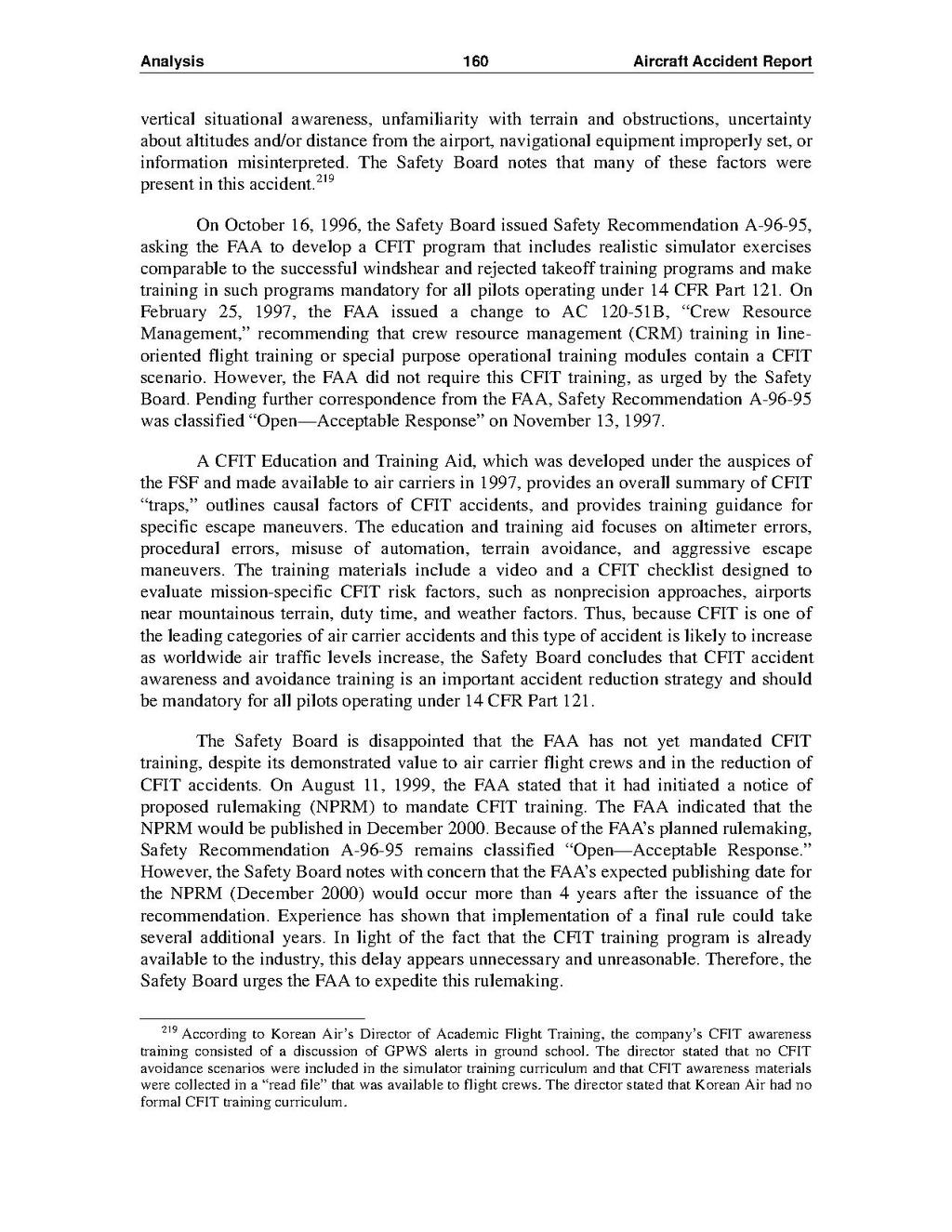vertical situational awareness, unfamiliarity with terrain and obstructions, uncertainty about altitudes and/or distance from the airport, navigational equipment improperly set, or information misinterpreted. The Safety Board notes that many of these factors were present in this accident.[1]
On October 16, 1996, the Safety Board issued Safety Recommendation A-96-95, asking the FAA to develop a CFIT program that includes realistic simulator exercises comparable to the successful windshear and rejected takeoff training programs and make training in such programs mandatory for all pilots operating under 14 CFR Part 121. On February 25, 1997, the FAA issued a change to AC 120-51B, "Crew Resource Management," recommending that crew resource management (CRM) training in lineoriented flight training or special purpose operational training modules contain a CFIT scenario. However, the FAA did not require this CFIT training, as urged by the Safety Board. Pending further correspondence from the FAA, Safety Recommendation A-96-95 was classified "Open--Acceptable Response" on November 13, 1997.
A CFIT Education and Training Aid, which was developed under the auspices of the FSF and made available to air carriers in 1997, provides an overall summary of CFIT "traps," outlines causal factors of CFIT accidents, and provides training guidance for specific escape maneuvers. The education and training aid focuses on altimeter errors, procedural errors, misuse of automation, terrain avoidance, and aggressive escape maneuvers. The training materials include a video and a CFIT checklist designed to evaluate mission-specific CFIT risk factors, such as nonprecision approaches, airports near mountainous terrain, duty time, and weather factors. Thus, because CFIT is one of the leading categories of air carrier accidents and this type of accident is likely to increase as worldwide air traffic levels increase, the Safety Board concludes that CFIT accident awareness and avoidance training is an important accident reduction strategy and should be mandatory for all pilots operating under 14 CFR Part 121.
The Safety Board is disappointed that the FAA has not yet mandated CFIT training, despite its demonstrated value to air carrier flight crews and in the reduction of CFIT accidents. On August 11, 1999, the FAA stated that it had initiated a notice of proposed rulemaking (NPRM) to mandate CFIT training. The FAA indicated that the NPRM would be published in December 2000. Because of the FAA's planned rulemaking, Safety Recommendation A-96-95 remains classified "Open--Acceptable Response." However, the Safety Board notes with concern that the FAA's expected publishing date for the NPRM (December 2000) would occur more than 4 years after the issuance of the recommendation. Experience has shown that implementation of a final rule could take several additional years. In light of the fact that the CFIT training program is already available to the industry, this delay appears unnecessary and unreasonable. Therefore, the Safety Board urges the FAA to expedite this rulemaking.
- ↑ According to Korean Air's Director of Academic Flight Training, the company's CFIT awareness training consisted of a discussion of GPWS alerts in ground school. The director stated that no CFIT avoidance scenarios were included in the simulator training curriculum and that CFIT awareness materials were collected in a "read file" that was available to flight crews. The director stated that Korean Air had no formal CFIT training curriculum.
